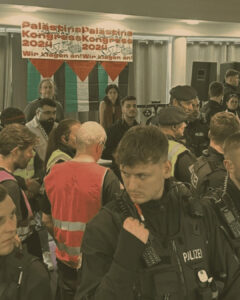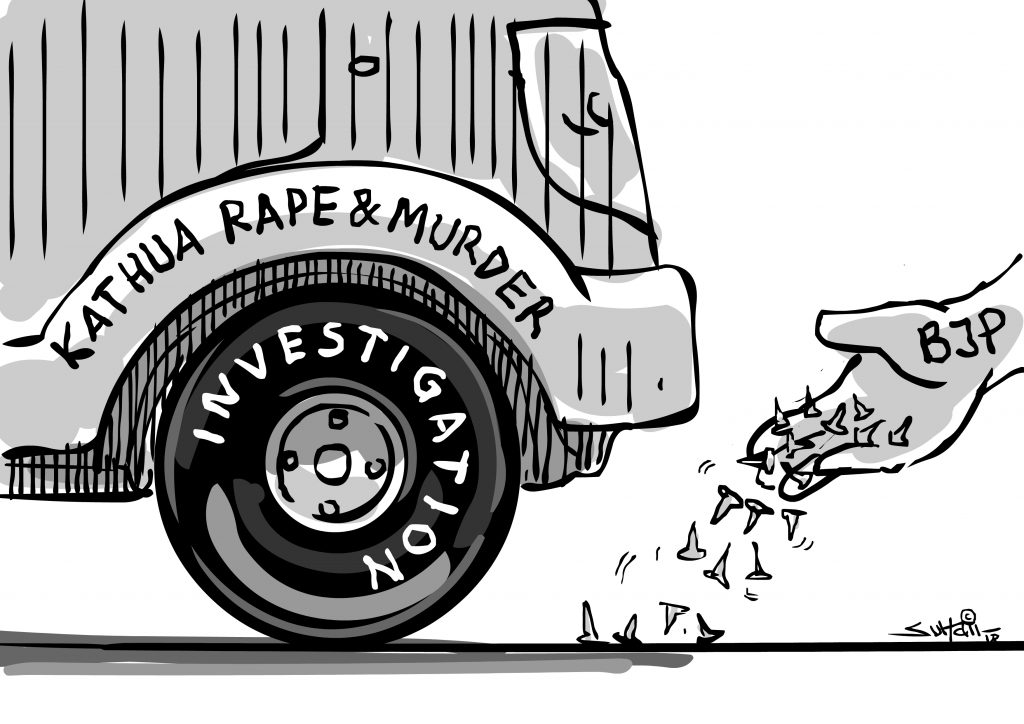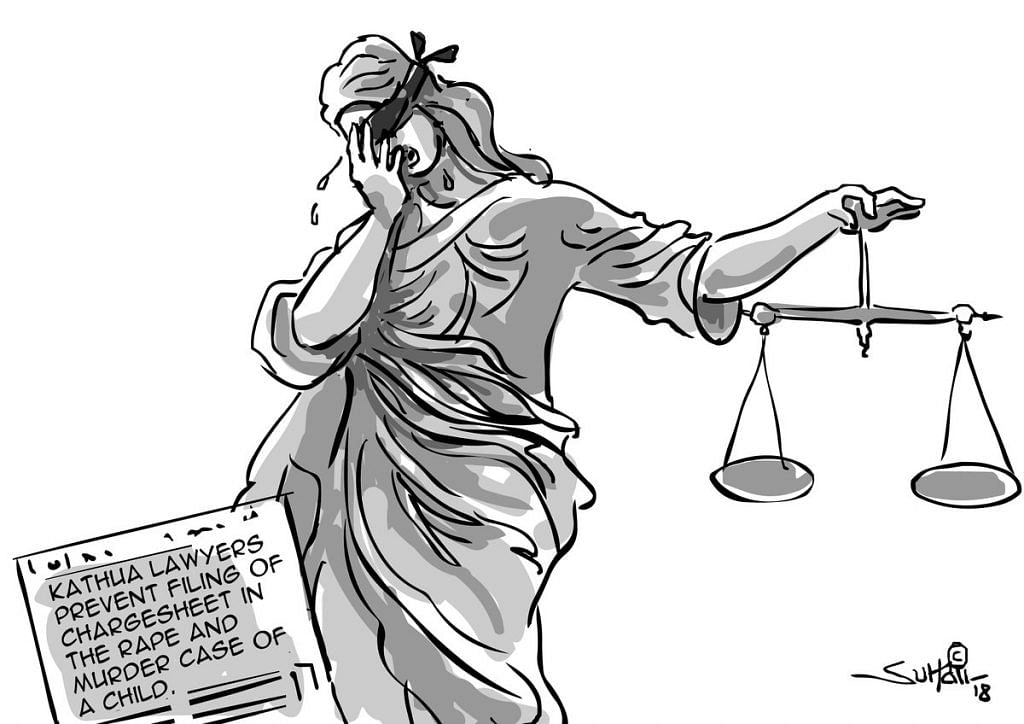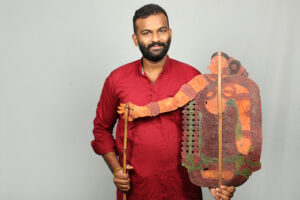
The Kathua rape case: A story of militarization, violence and justice

An eight-year-old Bakherwal Muslim girl went missing from Rasana village in Jammu and Kashmir’s Kathua district on 10 January 2018. Her family filed a First Information Report two days later. On January 17, 2018, her body was recovered from the forest near Devisthan temple in the area. The post-mortem report has confirmed that she was raped and the cause of death has been listed as “asphyxia leading to cardiopulmonary arrest”.
She was abducted, imprisoned, given Epitril (a drug used to treat seizures and panic attacks), and, sexually assaulted at least on five occasions by four different persons – a juvenile, Parvesh Kumar, Vishal Jangotra, and, a local Special Police Officer, Deepak Khajuria. Between her disappearance and the discovery of her dead body, a Head Constable, Tilak Raj, and, a Sub-inspector Anand Datta, received money from one of the main accused, Sanji Ram, to hamper the search for the girl.
The police, therefore, did not search Devisthan temple, where the child was held captive. On finding the body, evidence was not gathered properly, and, some evidence was tampered with before submission for forensic testing. In addition to this, the juvenile accused was coached by the police to take the blame for the rape and murder and not implicate any of the others.
We are publishing the charge sheet, along with responses from scholars, writers, artists and citizens who place the rape and the gruesome murder in the larger context of occupation, militarization, use of rape as a weapon of war in the valley, settler colonialism, caste and finally break down of constitutional morality.
Scholars, Writers, Artists and Citizens respond
Ather Zia, Anthropologist, Writer, Poet and Activist
The murder-gang rape of a minor child A from Kathua is soul crushing. It must not be seen as a social-sexual crime but one that is deeply political and tied to the larger issue of the militarization, occupation and systematic use of rape as a weapon of war in the region. This case involves a premeditated plan to strike fear in the Gujjar-Bakerwal (migratory pastoralist) community and the crime branch has proved this. Such extreme violence on a young child is incomprehensible. The charge sheet is filled with the savage acts that were meted on the body of the young child who was chosen because she was a soft target. This gang-rape murder cannot be treated as apolitical since it is proven beyond doubt that it was planned to drive out the Gujjar-Bakerwals who are a marginalized Muslim community. Their presence has been a matter of growing strife for the local Hindu community. Sanji Ram who is now proven the main mastermind has a clear track record of inciting sentiments against the Muslim community and it is reported he has even been harassing their women in the past. Sanji Ram groomed his nephew to kidnap the A. In this they were aided and abetted by Deepak Khajuria an SPO in the local police force who is also the mastermind and has a track record of spewing hate against the Muslim community. It has been proven that he along with the members of police and other men (currently 8 in total) tried to cover up the case. They received clear political patronage to get the community activist Talib Hussain detained and cause impediments in the investigation. The advocate for A, Deepika Singh continues to be harassed to drop the case by the Bar Association of Kathua. In an unprecedented turn of events, the Bar has mobilized in favour of the rapists and have caused impediments in filing the charge sheet against the accused. The Hindu community, under the banner of Hindu Ekta Manch, continues to protest and strike demanding the rapist-murderers be released. While showing extraordinary strength in face of immense adversity, Mohammad Yusuf Pujwala, A’s father along with his family, has fled the area due to threats. It must be noted that the Hindu community did not allow A to be buried in the area even though the family lawfully own space for burial. In 1947 Jammu region became dominantly Hindu after a large scale Muslim massacre was carefully orchestrated during the partition. While this shameful history is carefully hidden from common view, A’s case brings back the horrors of a communal past, and the potential for no doubt mindless but orchestrated violence that Indian settler colonialism is capable of bringing back or rather has brought back.
Suhail Naqshbandi, Artist and Editorial Cartoonist & Art Director at Greater Kashmir.


Even after her brutal death, A continues to be humiliated. Her soul must be feeling the pain of how her tormentors are being supported by a large section of people, because of her belonging to a certain religion. Something, she as a mere 8-year-old, would never understand. Her soul cannot rest in peace till justice is meted out to her. There should have been a unanimous voice across the board. How on God’s earth can anyone even take sides in this extraordinary case? After all, it is a kid, who was made to go through hell. While the state government’s refusal to hand over the case to the CBI is a right move, this it is not enough. There should have been no tolerance demonstrated by the Chief Minister Mehbooba Mufti, especially when two of her cabinet ministers went to put their weight behind those who supported the rapists. You cannot seek justice for the victim while sitting next to those who try to shield the accused. With this, a new lowly and dangerous precedent has been set. From now on, rapists and murderers will have a support system. And the victim’s religious and geographical background will decide whether they can get justice.

Mona Bhan, Associate Professor of Anthropology, DePauw
Without doubts, the gut-wrenching violence against A must be condemned unanimously. But that the mainstream outrage in India is blindly equating it with the Nirbhaya case, without any acknowledgement of the larger political context of occupation in Kashmir, is a violent erasure of Kashmiri subjectivity, and of the lawlessness and impunity with which India has held on to Kashmir. It is convenient for Indian liberals to rally around gendered modes of violence and to claim A as India’s daughter. And yet such selective outrage is dubious at best: it appropriates Kashmiri bodies to bolster ongoing political struggles in India against a fascist right-wing regime, while completely ignoring Kashmir’s troubled relationship with India. Regardless of who is or is not at the helm of political power, India is the face of fascism in Kashmir. To redeem what is left of their progressive politics, Indians must fight alongside Kashmiris for their right of self-determination and demand an end to India’s unjust rule in Kashmir, which has for decades used rape as a weapon of war. Ironically, to make A’s case the center of their outrage is to purposefully condone the violence that is perpetrated against Kashmiri bodies on a regular and systematic basis. It is time Indians use A’s case to acknowledge and counter the everyday despotism of India’s military regime and demand an end to India’s illegal occupation of Kashmir.
Nawaz Gul Qanungo, Journalist
An overwhelming majority of Kashmiris favour an end to Indian rule. Kashmiris have remained invested in pro-independence political movement right since its controversial accession to the Indian union in 1947, a moment that also saw India employ in response extreme forms of political unfreedom and suppression. This has exacted an enormous cost from the people of Kashmir, not least since 1989 when the movement turned into an armed rebellion to which the Indian state responded with brute military force. The decade of 1990s remains Kashmir’s bloodiest under Indian rule.
More than 70,000 people have been killed in the military crackdown against the armed uprising. Extreme levels of militarization—Kashmir remains the most heavily militarized territory in the world—employed by the Indian state meant that basic human rights are violated with impunity. More than 8,000 people in Kashmir have been subjected to enforced disappearance. In recent years, more than 3,800 unmarked and mass graves have been discovered in the valley. And evidence remains littered on India’s systematic use of torture in Kashmir.
Rape has similarly been used by the state as a weapon of war. Sexual humiliation, torture, and assault have been perpetrated upon not just individual men, women, and children, but even entire villages.
This violence and brutalization by the Indian forces has been perpetrated within the realm of a gory culture of lawlessness and impunity that’s been bolstered and aided by a wide range of Indian institutions, both from within the state and without. The Indian mass media, for one, is one such instrument that has ensured that Indian public opinion remains strongly in favour of such impunity—all in the name of national interest and state security. The Indian military establishment has thus traditionally been celebrated as the “most disciplined” of India’s state institutions. In this, the Indian judiciary has played no small part. Even the most brutal violations at the hands of the Indian forces—even amidst overwhelming evidence—have therefore gone unpunished if not outright unacknowledged.
The spectacular rise to power of the extremist Hindu right-wing in India was attended not just by the idea of Hindu nationalism and establishment of a Hindu state but it also came riding upon just such consciousness of a ruthless, invincible military power. It is telling how in the last four years India’s Hindu right-wing has successfully created an open spectacle of extreme violence perpetrated upon its minorities—invoking nationalism on one hand and gaining impunity on the other.
The abduction, gang-rape and murder of an 8-year-old Bakarwal girl child in Kathua by members of the Hindu right-wing and state police with an intention of cleansing the region of its Muslim population, blatant attempts by the investigating agencies to cover up the gruesome crime, and the open support for the alleged perpetrators extended by none other than ministers of the state government is all fundamentally just a continuation of India’s routine project of control through violence in Kashmir. It is, however, also a most chilling sign yet that India’s impunity in Kashmir, as we know it, is indeed no longer the sole prerogative of its military establishment.
Nissim Mannathukkaren, Chair, International Development Studies, Dalhousie University, Canada.
The response to the brutal devastation of the life of the eight-year-old A is one which should leave a lasting imprint on India as a nation. And the early signs are terrifying. It is not that the land of the million mutinies has not seen violence. In fact, it is no stranger to it, from state-sponsored communal pogroms and riots to quotidian acts of
oppression, especially perpetrated on Dalits and Adivasis, to recent lynchings of Muslims. It is, also, not a stranger to rapes, even of young children. But what marks the case of Asifa is the brazen and public display of support for the perpetrators of the crime by the ruling party, and its appropriation as a nationalist act through an open mobilization of the Hindu majority. Add to this the deafening silence of the Modi government.
After all, A belongs to Jammu and Kashmir, the most militarized zone in the world, where normal laws and protections do not apply. It is where the Armed Forces Special Powers Act is in place, which has ensured that no Army or paramilitary personnel have been brought before a civilian court in three decades of militancy. Kashmiris are paradoxically excluded, yet included. Such states of emergencies are called “state of exception” by Agamben. Is it then surprising that some of the main actors in the A rape and murder are policemen belonging to a force called Special Police Officers, specifically constituted to fight militancy and which is ill-trained and paid less than the normal police force? A is thus not just the object of brutal gender violence, but also of the violence of the nation-state, of rape as a political tool. Thus, violence on girls and women becomes a nationalist act par excellence. The impunity of the security forces does not derive just from a pathological masculinity but also from the nation-state’s states of exception. The calls to protect children with further stringent laws or capital punishment for the rapists do not address this fundamental fact. A’s fate was sealed as she belonged to the nomadic Bakerwal community, officially Muslim. And the community had to be driven out to maintain the demographic integrity of the region. The act against A was planned for months; it was not just a criminal act but tied to the larger project of state-making. All those well-intentioned people who have come out in support to reclaim her as “India’s daughter” should not be oblivious to this reality.
That is why Farooq Dar, a Kashmiri Muslim was tied to the front of an army jeep and paraded. That is why Pehlu Khan’s killers roam free, and supporters of Afrazul’s killer fly a saffron flag atop a district court. And that is why the national flag was draped over the killer of Akhlaq. Therefore, the lawyers of the Bar Association preventing the filing of the charge sheet in the A case is a natural and heinous culmination of this state of exception. The response to A should leave no doubts about the fact that the present regime led by Narendra Modi has lost the moral right to govern. But the state of exception is such that it does not allow us to talk about morality and ethics.
Sudipto Mondal, Writer and Journalist
Jason Jeremias, Artistic Director, Price of Silence
The facts about A’s gang-rape and murder speak silences that run deeper than global headlines prefer, inquire, investigate, or dare to pronounce. A’s rape was aggressed by guerrilla Hinduvata nationalism, sanctioned by the ruling party, ruling caste, the majority, the state and its terrorist affiliations. A’s murder was an orthodoxy assassination of a girl child, whose body was a pronunciation of an omitted narrative to signal fear and anxiety translated in her blood to the women of Jammu and Kashmir, whose existences fight for a liberation in silenced narratives. A’s existence has been condensed to eight hundred words, none of which can convey the value of her breath, nor amplify a scream clinging to life too late to be answered. The world has been silent to the plight of women of Kashmir. No words now can pull together the silence of the global media in an annunciation that speaks today in mourning what it ignored the previous day when the opportunity still existed for A to live into another day. ![]()
Mou Banerjee, Harvard trained historian specializing in Modern South Asian History
The tormentors of the eight-year-old girl from the nomadic Bakherwal community, whose abduction, gang-rape and murder in Kathua has convulsed Jammu and Kashmir, probably do not deserve any such compassionate gesture of humanity. The charge-sheet filed in the case, after much politicking and barbaric display of support for the accused by state politicians and lawyers, makes it clear that these men afforded none to their victim. They kidnapped her, restrained her in a temple, starved, drugged, repeatedly sexually assaulted, and finally murdered her. The choice of A was pre-meditated, carefully thought out and executed with relentless brutality through a close collusion between the men who held considerable local authority in the area, Sanjhi Ram and his nephew, and the local agents responsible for upholding law and order, SPO Deepak Khajuria and his collaborators, including head-constable Tilak Raj. Raj accepted a substantial bribe from the accused and actively tampered with evidence. Chillingly, and in a mockery of faith, Ram and his nephew performed a number of rituals in the temple to drive away the Bakherwals, while little A, drugged and raped multiple times, lay there helpless and in all probability terrified and traumatized. A friend of Ram’s nephew was invited in from Meerut to violate her, and Khajuria himself assaulted the little girl one last time before she was slaughtered. But let us move away from the rhetoric of empathy for the child victim of adult perversions – a narrative common enough in India to be shockingly unremarkable. The intent and motive behind the abduction and rape also merit close attention. The victim was chosen because she belonged to the nomadic community which the accused had previously complained was encroaching on their pasture and forest lands, and therefore needed to be taught a serious lesson, enough to frighten them away from Kathua and Rasana. The perpetrators also belonged to the Hindu community, while the victim and her family and tribe are Muslims. There has been constant fear-mongering in Jammu that the Gujjar-Bakherwals, who make up 11% of the population, and enjoy some degree of protection because of the ST and Other Traditional Forest Dwellers (Recognition of Forest Rights) Act 2006, are actually engaged in changing the demographics of the valley – “making” Muslims a majority in Jammu. This, of course, is a common scare-tactics. Nomadic tribes in India have borne the brunt of forcible sedentarizing efforts since the early colonial period, and their rights to grazing and forest land have been increasingly under threat in postcolonial India and in Jammu and Kashmir. The intent behind the bestial torture of the smiling little girl whose photograph has been circulated in social media is clear. Her suffering was a way to terrorize, subjugate and cleanse her community, in service to the vested economic and political interests of a section of Kathua’s residents, represented by Sanji Ram, Deepak Khajuria, et al. The accused have been supported by right-wing Hindu political parties, with the national flag being used in such processions. Violent communal tension has erupted in the area. The prosecution lawyer fighting A’s case, Deepika Singh Rajawat, has said she is being threatened by the president and members of Jammu’s Bar Council to withdraw from the case. There has been political pressure to transfer the case to the Central Bureau of Investigation (CBI), which is controlled by the ruling BJP alliance at the centre – implicit of course is the sense that the accused would be treated more leniently.
Moral outrage socially performed can be a constructive force, but only if there is a common consensus on basic ethical norms underlying common interactions. Yet, as A’s case signals, in the politically and morally divided India of today, which is a democracy on the brink of despair, there is no common language of exchange or an empathetic vision for a shared future.”





